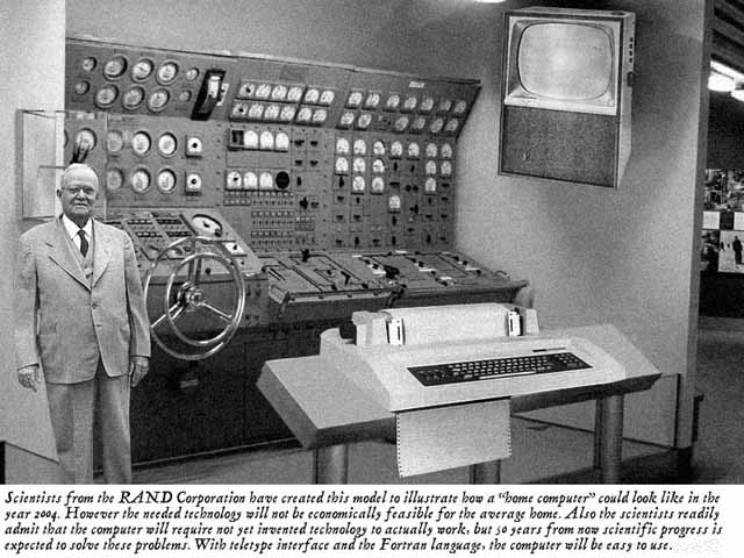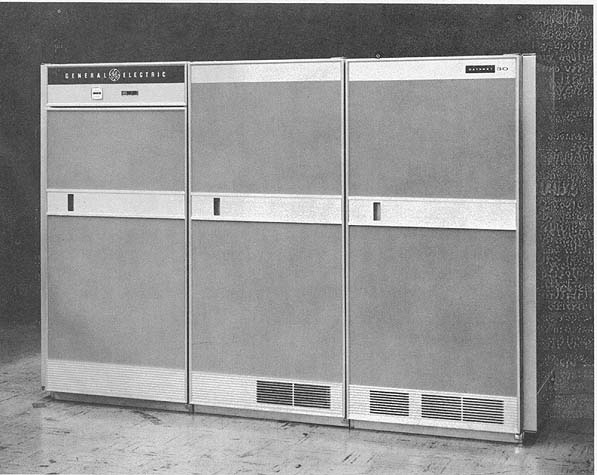Home Computer of the Future
The following picture is cute. However, there are a number of questions I have about it.

- The article implies that the date of the picture is 1954. But isn't that keyboard in front vintage 80's?
- Isn't the keyboard the wrong scale? Would the man's hands even fit on it?
- What in the world is that wheel for?
- Some kind of mouse?
- A crank to start up the hard disk?
- Is the man Harry Truman?
- What could all those guages be for?
- I wish we were still using Fortran
- I remember now, this is one of the sets from TOBOR the magnificent. Remember when he was dodging the asteroids? Hmmm, TOBOR was the first to play the "Asteroids" video game!
!commentForm
**********
The image was an entry in a fark photoshop thread not so long ago - it's a originally a submarine control mockup:
http://forums.fark.com/cgi/fark/comments.pl?IDLink=1115586
The photoshopped version is an entry from a fark artist named lukket (and props to him).
Footshot.
**********
I doubt if it is real. The 'teletype' looks a lot like a DecWriter[?],
circa 1980. The lighting is wrong, not even a good PhotoShop[?] insert.
The 'Computer' should have more lights and switches, if I remember
a late 50's GE DataNet30[?] correctly.
Looks more like a control panel for a small power plant, perhaps
hydroelectric.
The caption is interesting. When IBM developed their first
commercial computer, they figured the worldwide market at
about 7 machines. Nobody said anything about 'home'
computers.
I'll vote that the whole thing is bogus. But cute.
Old Grouch
- HI GROUCH! SABA. It's Captain Cork here.
- I remember that old Datanet 30. It had a huge disk drive with 10 or more platters if I recall. The platters were about 48" in diameter, and half an inch thick. It was an accumulation of metal that had to weigh half a ton.
- Each surface had it's own, pneumatically driven, seek arm. You could see the arms moving around inside the disk because the disk sat 4' off the ground and there was a huge window you could look in to see the spinning platters and heads.
- Seek time was on the order of .5 seconds.
- The huge axle was suspended in Mercury bearings if I remember correctly.
- One day we looked and saw little metal filings falling out from the bottom.
- We figured that wasn't a good thing, and powered it down.
- The repairman found that the bearings were dry. He told us about how one of these platters cut loose once and ripped through a concrete block wall and embedded itself into a Cadillac.

Yes, that old DN30 was quite a beast. That disk drive had platters that were 4 feet in diameter and .5in thick, solid steel. Each platter had at least two different seek arms, pneumatically driven. Yes, seek time was about .5 - .9 sec. I think there were 11 platters. The floor shook...
Do you remember that the UARTS were under program control. There was an interrupt for every bit, and the computer had to issue instructions to shift the next bit out the dozen or so UARTS that went to Local 705? Do you also remember the Datavue terminals operating in half duplex mode? The operators would hit return and then have to powercycle the terminals to get the half duplex line to turn around. (Power cycling was a way to drop CTS so that the computer would grab it...)
Back then we thought that 300 baud was lightning fast!
And then there was LNK.
Do you remember that the UARTS were under program control. There was an interrupt for every bit, and the computer had to issue instructions to shift the next bit out the dozen or so UARTS that went to Local 705? Do you also remember the Datavue terminals operating in half duplex mode? The operators would hit return and then have to powercycle the terminals to get the half duplex line to turn around. (Power cycling was a way to drop CTS so that the computer would grab it...)
Back then we thought that 300 baud was lightning fast!
And then there was LNK.

Terminals ?!? They used Teletypes. A/KSR-37's. We had the stupid CRT's. You could scan all the serial lines on the '30 with a single instruction. And get one bit per. Sort of. As for the disk drive: 18 platters, 36" dia, two independant seek arms per, two sets of heads per arm (so it didn't have to seek as far, "flying heads" (with a small air hose to each head) Voice coil positioning. Took IBM years to copy it. And mercury bearings. With the controller in a separate box, just as big. About 16 megs. Don't know if that was bytes or 18 bit words. The tape drive was a real gem. 7-track, a few hundred bpi. And of course, the paper tape bootloader. Some genius (Sader ?) bypassed the thermostat on the air conditioning. Full tilt, 24/7. When they shut the GE down, the computer room froze. Frost on the windows. Killed the 360 and the 620f. We probably got blamed for that...


Datanet 30
What was the name of the operator who dropped the 2314 pack on the floor, bent the hell out of it, then screwed it into a drive anyway. Chewed up the drive. Then screwed another disk into that drive. Chewed up that disk. Then screwed that disk into another drive. Chewed up that drive. 2 packs. 2 drives. One idiot.

I think it was Louie Johnson. Wasn't entirely his fault. GE had an odd pack from another vendor for trial. The trial disc pack cover didn't hold the IBM disc pack secure and it fell out.
Add Child Page to HomeComputerFromTheFuture